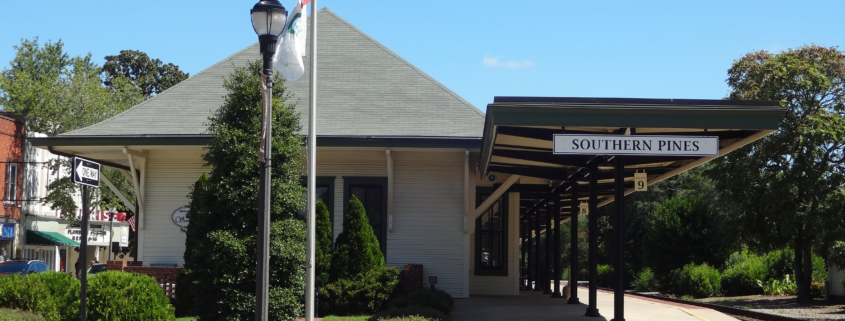The History of Southern Pines
The Fascinating History of Southern Pines, North Carolina
Southern Pines, a charming town nestled in the heart of Moore County, North Carolina, is famous for its picturesque beauty, warm climate, and fascinating history. Over the years, the town has been home to different groups of people, including Native Americans, European settlers, and African Americans. Let’s take a deep dive into the rich history of Southern Pines.
Early History
The land that Southern Pines now occupies was initially home to the Sissipahaw tribe of Native Americans. The tribe had been living in the area for centuries before the arrival of European settlers. In the late 1700s, the Wilmington to Weldon Railroad began running through the region, putting the town on the map as a hub for commerce and industry.
As the railroad expanded, Southern Pines grew rapidly, and its economy centered around the production of high-quality longleaf pine. The pine was used to construct ships and buildings and became a valuable commodity in the area. The town also became a sought-after destination for wealthy tourists seeking a relaxing retreat.
For more information about the early history of Southern Pines, visit https://southernpines.net/about/history/.
The Civil War
During the Civil War, Southern Pines and the surrounding area were the site of several key battles and skirmishes. The town was occupied by Union troops for most of the war, and many of the town’s residents were forced to flee or risk being caught in the crossfire. Despite the chaos, the town’s economy continued to thrive, and the area remained an important transportation hub throughout the conflict.
For more information about Southern Pines during the Civil War, visit https://www.civilwar.org/learn/articles/battles-and-campaigns-southern-pines.
Reconstruction and Growth
After the Civil War, Southern Pines entered a period of rapid growth and development. The town’s economy diversified, and new industries such as agriculture, tourism, and manufacturing emerged. Many of the town’s historic buildings were built during this time, including the iconic train station and the Weymouth Center for the Arts and Humanities.
Southern Pines also became a center for education, with the establishment of several prominent schools and universities in the area. These institutions, including Sandhills Community College and St. Andrews University, attracted talented students and faculty from all over the country.
For more information about Southern Pines during the Reconstruction era, visit https://www.moorecountync.gov/about-us/history/moore-county-history-reconstruction-era.
The Civil Rights Movement
In the 1960s, Southern Pines, like many other towns in the South, became a part of the Civil Rights Movement. The town’s African American community fought for equal rights and access to education, housing, and other basic necessities. Despite facing significant resistance from some members of the community, they persevered and made significant strides towards equality.
For more information about the Civil Rights Movement in Southern Pines, visit https://www.southernpines.net/services/human_resources/equal_employment_opportunities.php.
Historic Landmarks and Attractions
Southern Pines is home to several historic landmarks and attractions that showcase the town’s rich and colorful history. Here are just a few of the highlights:
The Weymouth Center for the Arts and Humanities
The Weymouth Center for the Arts and Humanities is a historic estate located in the heart of Southern Pines. The center was built in the early 1900s by a wealthy businessman and philanthropist, and was later donated to the town for use as an arts and cultural center. Today, the center hosts a variety of events and activities, including concerts, exhibitions, and workshops.
For more information about the Weymouth Center, visit https://weymouthcenter.org/about-us/history/.
The Southern Pines Train Station
The Southern Pines Train Station is an iconic landmark that has been a fixture in the town since the late 1800s. The station served as a hub for transportation and commerce, and today it is still in use as an Amtrak station. The station’s architecture and history make it a popular spot for tourists and locals alike.
For more information about the Southern Pines Train Station, visit https://southernpines.net/visitors/train-station.php.
The Given Memorial Library
The Given Memorial Library is a historic library located in Southern Pines. The library was established in 1940 by a local philanthropist, and was named in honor of her late husband. Today, the library is home to a large collection of books and other materials, as well as a variety of cultural and educational events.
For more information about the Given Memorial Library, visit https://www.giventufts.org/about-us/history/.
The Shaw House
The Shaw House is a historic home located in Southern Pines that dates back to the late 1700s. The house is named after its original owner, Alexander McQueen Shaw, who played a key role in the development of the town. Today, the house serves as a museum and cultural center, offering a glimpse into life in Southern Pines during the 18th and 19th centuries.
For more information about the Shaw House, visit https://www.moorecountync.gov/museum/page/shaw-house.
In Conclusion
Southern Pines, North Carolina, is a town that boasts a rich and diverse history. From its early days as a stop on the Wilmington to Weldon Railroad to its role in the Civil War and Civil Rights Movement, the town has played a vital part in shaping the history of the region. Today, Southern Pines continues to thrive as a vibrant community, with a strong sense of pride and appreciation for its past. Whether you’re a history buff, nature lover, or just looking for a peaceful getaway, Southern Pines has something to offer.




Leave a Reply
Want to join the discussion?Feel free to contribute!